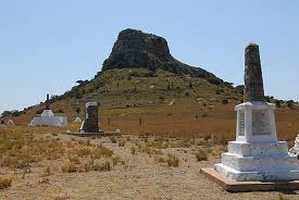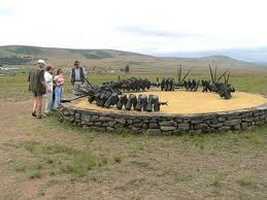Quick Facts: Dundee
- Iron Age Smelting Site
- Museums
- Historic Buildings / National Monuments
- Battlefields
- Baskets for Africa: these baskets are crafted by Zulu women using natural products e.g. grasses, barks, twigs etc.
- Chernova Potteries
- Isibindi Eco Reserve: this is a private game farm just beyond Rorkes Drift; visitors can experience a traditional Zulu village and enjoy a typical meal; white water rafting is also available here
- Bushman Paintings
- Cenotaph: memorial of the First and Second World War
- Fort Pine; built by the Royal Engineers in 1878\9; can be found on the farm Sheepridge
- Talana Museum
- Moth Museum (Memorable Order of Tin Hats)
- Hindu Temple
- Mosque
- Factory Tours: Consol, NLK Feed factory, Orange Grove Dairy
- Farmers Brewery
Distance to Airport: 242 km
Distance to City: 68
Introducing Dundee
The coal mining town of Dundee nestles in a valley of the Biggarsberg mountains in KwaZulu-Natal, South Africa. The town of Dundee forms part of the Endumeni Local Municipality in South Africa's Umzinyathi District. This region of KwaZulu-Natal is rich in coal deposits.
Dundee was established in 1882 after a discovery of the availability of coal closest to the surface by farmers. It is named after the hometown of a pioneering Scottish settler, Peter Smith. At first, Dundee was a farm named 'Talana farm',which was owened by Peter Smith, which he had brought from a Voortrekker settler, Mr Dekker. Three other men are credited with the founding of Dundee which are his son William Craighead Smith, the son in-law Dugald McPhail and a close family friend by the name of Charles Willson.
The town of Dundee is situated in the picturesque Biggarsberg which is the heart of Northern KwaZulu- Natal. Dundee is surrounded by historical remarkable mountains which of 'Indumeni' which can be translated as 'where the thunder rolls', 'Mpati' which means 'The place of good waters' and, and 'Talana', 'the shelf where precious items are kept'. Dundee is home to great evidence which can be seen in the lifestyle and rock paintings in caves and shelters that the San people once lived in this area about 4 000 – 5 000 year ago.
In 1889, Peter Smith founded the Dundee Coal Company and established his company at the London Stock Exchange. Soon after, Dundee emerged as a boomtown graced with stately homes. Pioneer traders from the Indian sub-continent settled here during the following decade, when Dundee became the meeting place of seven roads into the hinterland and coast of Africa.
The picturesque town of Dundee lies in a valley in the Biggarsberg at the foothills of the mighty Drakensberg in the heart of northern KwaZulu-Natal, South Africa. Dundee was founded by Scottish settlers in 1882. San people roamed this area and in the caves and shelters they left evidence of their lifestyle in rock painting. The South African town of Dundee was Peter Smith’s farm and he named the town Dundee, in memory of his original home in a small village near Dundee, Scotland in 1882. On 20.10.1899 the first shots of the South African war were fired - Battle of Dundee. Dundee was once a coal mining town, only one mine is still open.
Dundee is the central point from which to explore this corner of KwaZulu-Natal and the battle sites. It is rich in culture, arts and crafts with pockets of nature’s beauty.
Blood Heritage Site:
One of the most famous battles in South African history - monument consisting of 64 replica Voortrekker wagons cast in bronze and situated just as they were on the day of the famous battle.
Talana Museum:
This museum is just outside Dundee and comprises 17 buildings. The Zulu name “Talana” means “the shelf where precious items are stored”. On exhibit in this museum in Dundee are weapons, uniforms and artifacts as well as yearly re-enactments bring this history flooding back. Also on display is agriculture, mining, industry and domestic life. www.talana.co.za
Moth Museum: (Memorable Order of Tin Hats)
It is one of the best private collections. On display are unique military memorabilia dating from the Anglo-Zulu war to the present.
Rorke’s Drift Museum:
The Rorke’s Drift Museum in Dundee has attracted worldwide attention for its outstanding displays of the Anglo-Zulu War.
Historic Buildings in Dundee:
- Boswells Building erected in 1898; last remaining pre-1900 theatre in KwaZulu-Natal
- Dutch Reformed Church: completed in 1922; on the clock tower is an Anton Von Wouw sculpture and a plaque commemorating the Boers
- Police Station: Ghandi was charged here in 1913 for his role in the protest march
- Prince Imperial Memorial: this is in commemoration of Prince Louis Napoleon
Battlefields, KwaZulu-Natal:
- Blood River Battlefield – This battle was fought on 16.12.1838. A replica of the Boer laager can be found on the site as well as a memorial to the Zulu impi.
- Isandlwana Battlefield - On 22 January 1879 an entire British army was annihilated by a force of 25 000 Zulu warriors. Whie cairns scattered across the battlefield mark the positions of buried British soldiers. 80km from Dundee.
- Rorkes Drift Battlefield: 100 British soldiers defended this position against 4 000 Zulu warriors in a 12 hour engagement. A record number of 11 Victoria Crosses were awarded to the defenders. 42km from Dundee.
- Fugitives Drift - On this lonely hillside the two men responsible for saving the colours from the Isandlwana camp were killed and are buried. 15km beyond Rorkes Drift. The fugitives Trail follows the route along which the handful of survivors fled from Isandlwana to Fugitives Drift.
- Helpmekaar – This tiny village was the site of the British camp in 1878\9. The Star Fort is no more but the cemetery is a stark reminder of the loss of life in the war.
- Elandslaagte Battlefield – This battle was fought on 21.10.1899 between Boer and British.

.jpg)


.jpg)
.jpg)


.jpg)